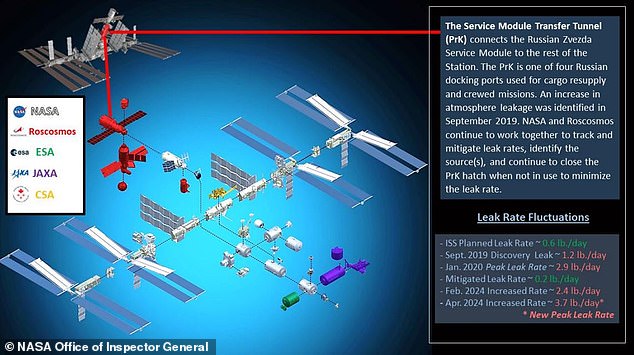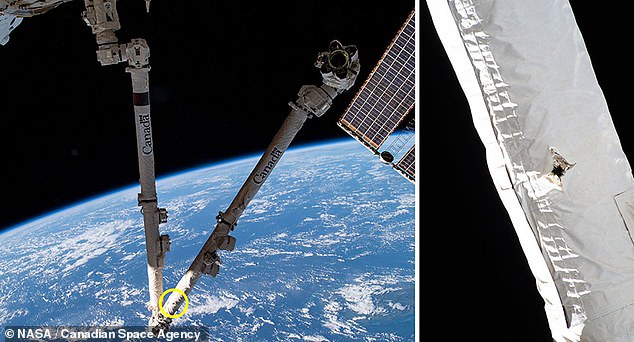Exactly how NASA might evacuate the ISS amid fears of leaks and cracks in the space station
A growing leak on the International Space Station has raised fears that astronauts on board may need to be evacuated, including the two stranded by Boeing’s Starliner.
All seven astronauts were forced to the American side of the orbiting laboratory due to 50 “points of concern” and four cracks in a Russian module.
If the leaks become severe, the space station can quickly lose oxygen and pressure.
The moment Houston sounds the alarm about a threat, astronauts would have to rush to close the hatch on the leaking section and get to the “rescue boats” docked on the ship.
A space expert told DailyMail.com that if evacuation became necessary, each crew would escape in their assigned NASA spacecraft, including the SpaceX Dragon capsule and the Russian Soyuz.
NASA’s Commercial Crew Program Manager Steve Stich said that in the event of an emergency, SpaceX’s Dragon can be launched in minutes.
The capsules are equipped with emergency suits so that the crew can quickly don the appropriate equipment as they flee the orbiting laboratory, saving even more valuable time.
However, the US space agency has admitted it is unprepared for the capsule’s failure due to the lack of ready-to-go vehicles, which could leave the crew stranded without a way home.
NASA has committed to fully utilizing and safely operating the space station until 2030, with plans to decommission the ISS some time afterward.
NASA has drawn up a plan for an emergency evacuation of the ISS and it could be used amid cracks and leaks in the ship. All seven astronauts remain on the American side due to a leak in the Russian module
Independent space safety expert Laura Forczyk told DailyMail.com: ‘If leaks on the ISS worsen significantly to the point where NASA and Russia conclude the situation is unsafe, this could mean the ISS will have to be dismantled sooner than expected.’
The main leak was discovered in a service module transport tunnel in the Russian Zvezda module provides station living quarters, life support systems, electrical distribution and data processing, flight control and propulsion systems.
American astronauts who came to the ISS on SpaceX’s capsule are prepared to escape with their spacecraft if necessary.
But the evacuation plan for Don Pettit, a NASA astronaut who flew to the ISS with two Russian astronauts in September aboard the Roscosmos Soyuz MS-26 spacecraft, is a little more complicated.
In an emergency, he would not return to Earth on Soyuz. Instead, he would have to cram into the SpaceX capsule, which was recently equipped with an extra seat in case Pettit needs it, NASA spokesman Jimi Russell told DailyMail.com.
It is unclear why Pettit would not return to the Russian plane, but some have suggested the swap could be due to growing tensions between Russia and the US.
NASA currently does not have an official evacuation plan for U.S. astronauts assigned to Russian spacecraft. But the agency has awarded SpaceX a $266,000 contract to build one.
In the event that the leaks, cracks and other problems made the entire ISS uninhabitable, the astronaut crews would follow protocol to take shelter in their respective spacecraft.

It is not the first time that the ISS has leaked. In 2018, astronauts rushed to repair a hole (pictured) that had appeared in the outer wall of the Soyuz capsule in the orbiting laboratory.

ESA astronaut Tim Peake took this photo in 2016 from Cupola, showing a circular chip with a diameter of 7 mm ripped out by the impact of a small piece of space debris
Each crew’s capsule has an assigned shelter-in-vehicle plan that will protect astronauts from threats aboard the ISS, and allow them to escape the space station if necessary, according to a September report from NASA’s Office of the Inspector General (OIG).
“It was designed with these types of contingencies in mind,” Stich previously said.
They also include astronaut suits, so crews can get dressed quickly and easily in an emergency.
According to NASA, it can take up to 30 minutes to get into a space suit.
Streamlining this process as much as possible would be critical in an emergency situation.
These vehicles would be the astronauts’ only hope of escape. If something were to happen to them, it would be a different story.
“Due to high costs and limited budgets, the lack of ready-to-go vehicles prevents the Agency from immediately responding if crew vehicles sustain significant damage and are no longer safe for crew evacuation,” the report said.
Russia’s Zvezda module was launched in 2000 and “served as the foundation stone for the station’s first human habitation,” according to NASA. But like the rest of the ISS, this module is aging and requires maintenance to keep working.
The leak has been going on since 2019, when air began escaping from the module’s transfer tunnel, a vestibule that separates the Russian docking port from the rest of the module.
There was no immediate danger, but it was eventually located and has been recovered several times over the past five years.

The Zvezda module is used to access a Russian cargo dock. Due to the escalating leak, the Russian space agency has agreed to keep the module sealed except when necessary
In 2021, a new leak was identified, also in the Russian Zvezda module, which was considered a ‘fairly serious problem’.
If the leak becomes severe, NASA and Roscosmos may be forced to permanently close the hatch to the affected tunnel.
And if the leaks were to worsen to a point where the habitability of the entire space station would be affected, astronauts would be forced to confine themselves to their spacecraft and possibly return to Earth.
Former NASA astronaut Bill Shepherd, who served as the first commander of the ISS from October 2000 to March 2001, told a House committee at the time that NASA and Russian engineers “don’t understand exactly why the cracks are appearing now.”
Shepherd echoed claims by Roscosmos, the Russian space agency, that it was “becoming a serious problem.”
Despite NASA’s repeated efforts to plug the main leak, the amount of air escaping from the station has only increased over the past five years.

NASA is now tracking 50 ‘points of concern’ related to a leak in Russia’s Zvezda Service Module Transfer Tunnel (labeled), which caused a leak in 2019

The Canadarm2 robotic arm was struck by space debris in May 2021, creating a hole that fortunately did not affect the functionality of the robotic arm
It was the focus of the OIG’s September report, which found that the leak reached record numbers in April, losing 3.7 pounds of air every day.
The OIG has increased the threat rating in NASA’s internal risk assessments to five out of five.
But this leak is just the tip of the iceberg. NASA officials said the Washington Post they are monitoring four other cracks and fifty ‘points of concern’ in the ISS.
Speaking to the Washington Post, NASA Administrator Jim Free said: “We have made clear the severity of the leaks several times, including when I was in Russia earlier this year.”
The cracks have been ‘all covered with a combination of sealant and plasters’ by Roscosmos and further repairs are underway.
But they remain a concern, especially since the leaks are located near a hatch. NASA and Roscosmos to open the hatch only when absolutely necessary and to keep it closed at night.
The aging ISS has remained in orbit for ten years longer than NASA originally planned.
According to the September report, the OIG identified 588 replacement parts that were functioning beyond their operational lifespan.
To make matters worse, OIG is monitoring several other risks that could endanger the ISS, including possible collisions with micrometeors and space debris.
NASA currently plans to decommission the ISS by 2031 and has commissioned SpaceX to build a Dragon-type spacecraft that could deorbit the station.
But there’s a chance that this recent plague of technical problems could shorten that timeline, according to space safety expert Laura Forczyk.
Although she said deteriorating geopolitical relations between the US and Russia pose the greater risk factor to the ISS decommissioning timeline.
